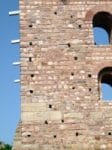The Man and the Mith
 Look closely at this detail of a tower in Turkey. Most of it is brick and dates from the Byzantine period but the lower courses contain some marble blocks – they are ancient. The marble was reused from an earlier structure, maybe one that stood on the same site. I’d like to think that they come from a fortress that stood in these parts 2200 years ago – the very place where Hannibal made his last stand against Rome.
Look closely at this detail of a tower in Turkey. Most of it is brick and dates from the Byzantine period but the lower courses contain some marble blocks – they are ancient. The marble was reused from an earlier structure, maybe one that stood on the same site. I’d like to think that they come from a fortress that stood in these parts 2200 years ago – the very place where Hannibal made his last stand against Rome.
The site is the ancient city of Libyssa, a port on the Astacene Gulf – today, part of Gebze, an industrial city near Istanbul, on what is now the Gulf of Izmit. It’s hard to imagine the Carthaginian lion here, so far from his stomping grounds further west.
Hannibal was the most dangerous enemy the Roman Republic ever faced. In the Second Punic War (218-201 B.C.) he swept through Italy like a demon, where he won an immortal victory at Cannae. After years of struggle, the Romans forced him to North Africa, where they finally defeated him.
A few years later, they drove him into exile in Anatolia. Hannibal made new allies in the East, and sucked Rome into new wars, but eventually they cornered him. In 182 B.C. Hannibal took poison here in Libyssa rather than fall into Roman hands.
The story doesn’t end there. As my good friend Adrienne Mayor suggests in her terrific book, The Poison King, Hannibal left an anti-Roman poison in the Anatolia where he died. Hannibal may have inspired the war against Rome of the Anatolian King, Mithradates of Pontus – a kingdom not far from the tower in the photo. Like Hannibal, Mithradates subjected Rome to decades of war (88-63 B.C.) and humiliating losses before they finally defeated him. Mithradates too committed suicide rather than accept capture.
But the larger point is the mystique of rebellion, that echoes down the years to today’s rebels against the West. How many modern Hannibals and Mithradates are still with us!